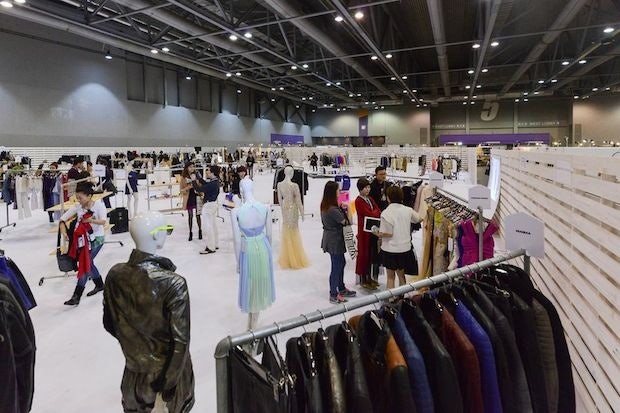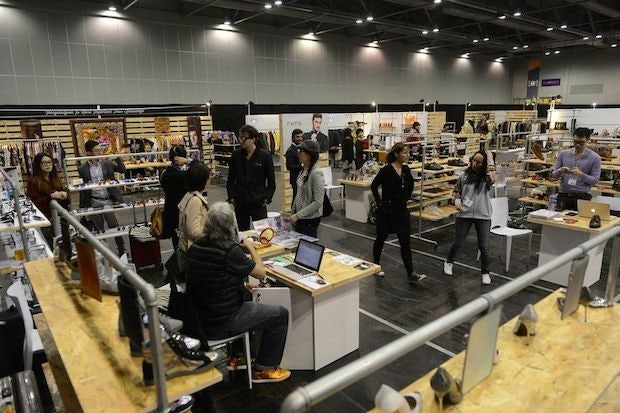
The HUB's February 2014 trade show. (Kitman)
Next week marks the third iteration of The HUB, Hong Kong's first fashion trade show aimed at connecting niche, premium international brands to Asian buyers. Over three shows, The HUB will have welcomed over 200 exhibitors from most of the countries of Europe, North America, China and Hong Kong, Japan, and several Southeast Asian countries. Buyers come from Japan, Southeast Asia, Hong Kong, Australia and other regions.
The HUB arrives as the Chinese market matures and the growing middle class is increasingly looking beyond major labels. According to cofounder Peter Caplowe, he and partner Richard Hobbs started the show because there was really nothing like it to connect the growing number of brands trying to enter the burgeoning market.
Caplowe, an entrepreneur who has been based in Hong Kong since 2000, comes from a long history of discovering and building brands. In 1994, he introduced Japanese cult denim label Evisu to the international market, taking it from a 14-pair-a-day, hand-crafted business to a 100 million dollar enterprise. It revolutionized the denim industry along the way, helping spawn the premium denim category.
With The HUB, Caplowe is looking again to introduce niche brands to a new market, but with some added challenges, notably the near absence of multi-brand stores in China. Historically in more developed markets like Europe, the United States, and Japan, multi-brand stores have played a key role in nurturing up-and-coming fashion labels. In China, most retail spaces are either mono brand or department stores operating on a concession model. “With no multi-brand channel, there is no way for new brands or designers to get started—this is the roadblock which is preventing the China fashion market from moving forward,” said Caplowe. “There is just no way for most designers to take on that cost in time and money at the same time as developing good design and product.”
I had the opportunity to speak with Caplowe on his recent trip to Shanghai about the current state of multi-brand stores in China and why they are necessary to develop a robust and sustainable local fashion industry.

The HUB founders Richard Hobbs (left) and Peter Caplowe (right).
As Chinese consumers become more sophisticated, we are starting to see a growing demand for niche labels. Yet, market entry remains difficult for small to mid size brands. What major challenges do such brands face in entering the China market?#
Many of these challenges like marketing and gaining visibility, getting retail space, etc. are highly related. Look around the streets of Beijing, Shanghai and, increasingly, cities like Chongqing, Xiamen, and Guangzhou and you see the hunger for style; the multi-brand channels of retail are expanding. So the basic challenge that small and sized brands faced of Chinese just wanting big brands is starting to diminish.
Europe and North America have an abundance of independent boutiques and department stores, but China has traditionally been mono-brand stores and non-buying department stores. With a few exceptions such as Lane Crawford, the vast majority considered department stores out here are really just concessions, stores-in-store. The costs of marketing are a huge challenge for relatively unknown brands, but much of that can be reduced if they are visible to consumers on the retail level. Other challenges are the higher cost of goods in China versus abroad and the difficulties with the health checks surrounding importation. Good partners can be invaluable in solving some of these problems.
What role do multi-brand stores play in promoting smaller brands?#
Most rising designers and brands would never be able to develop without it. Designers would have to be retailers, which, beyond the obvious cost of rent, means designers must become experts in designing and operating shops. As the typical minimum order quantity for a factory to produce their goods is 200-300 per style, it is basically impossible for a start-up brand or designer to get an order for a single shop produced.
The way brands and designers in the West get around this is to show their collections to multi-brand buyers and then collect sufficient orders from them to place their bulk seasonal production with factories. With no multi-brand channel, there is no way for new brands or designers to get started—this is the roadblock which is preventing the China fashion market from moving forward. There is just no way for most designers to take on that cost in time and money at the same time as developing good design and product.
The multi-brand stores bring niche products to [the] market, which means they assume some the cost of the retail and also much of the marketing. Buyers for multi-brand stores tend to understand the needs of consumers in their communities or in the niche markets that they serve. This curatorial role in turn helps them to, on the one hand, shape the taste of consumers and, on the other, give valuable feedback to designers.

The HUB's February 2014 trade show. (Kitman)
What is the current state of multi-brand stores in China and why have they been slow to develop?#
This is a very exciting time. I would suggest anyone interested in investing in retail explore this area as I believe it will be the new growth sector. Though numbers are still low by Western and Japanese standards, we see interesting multi-brand retail cropping up in cities all over China. The Fashion Door in Guangzhou, Triple-Major in Beijing, Shanghai, and Chengdu as well as many others are all great concepts. Dong Liang, BNC, Project Aegis, Le Lutin, Galatea Wan—there are many examples now.
This has been slow to develop—and will still face challenges—-due to issues related to location, distribution on the mainland, and maturity of the market. Location may be the biggest challenge since rents in shopping centers tend to be prohibitive for independents while the street retail culture is limited outside of Shanghai. Distribution or finding the product has been an issue because retailers had to travel to Europe or North America (before The HUB) to find these brands and working out favorable agreements was often difficult. As for maturity of the market, the more middle-class segments were not as well-formed or cosmopolitan in their taste until recently.
There has also been a "false market" where domestic brands with strong financing and connections with manufacturers and shopping mall operators have been able to start brands that have no real design concept or marketing edge have been able to set up "brands" and make very high margins, as the price points in the main malls are set by the luxury brands who were the first movers into the China market. This has in turn allowed the landlords to charge exceptionally high rents for such an immature market. As the Chinese fashion consumers become savvier and see through these "no idea" brands, the landlords will have to accept lower rents which allow multi-brand stores to operate profitably and bring through the 'real' brands, whether domestic or imported.
What efforts does The HUB make to promote both brands and the multi-brand concept?#
Through our personal networks and media, we've been spreading our message about authenticity and quality in brands as well as showing our commitment to supporting the development of multi-brand retail in this region. Specifically, we have organized a range of events like the Multi-Brand Forum in Beijing and, this time at The HUB, we are cooperating with the China National Garment Association to stage a Hong Kong version of the China Fashion Forum, which has been going for 20 years in Beijing. We're also working on a guide to multi-brand retail in China that should be completed in time for the next edition of The HUB.
Perhaps the main initiative that we've organized to support young brands is the Greenhouse, a district within The HUB dedicated to progressive labels from Asia and beyond. We offer this space at a reduced price and have attracted names like Zhang Chi, Vega Wang, V-Major, Haizhen Wang—really some of the best in fashion from China.
At this edition of The HUB, we have two special collaborations with Beijing-based designers. One is a retrospective exhibition of the most significant works to date of Vega Wang. The other is a collaboration on a silk scarf with Sefhyir, a creator of beautiful prints—kind of China's Hermès.
What makes The HUB unique as far as regional fashion trade shows go?#
The HUB is the premium fashion trade fair in Asia. I believe it is our commitment to authentic brands that have a story that makes us different as well as our deliberate effort to attract only appropriate attendees. We avoid the perils of other fairs in the region that have a messy, overwhelming feel that is neither conducive to business nor very stylish.